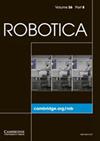基于机器人辅助照相机支架能力图的机器人底座放置和工具安装优化
IF 2.7
4区 计算机科学
Q3 ROBOTICS
引用次数: 0
摘要
在腹腔镜手术领域,目前的研究重点是开发新型机器人系统,以协助医生进行复杂的手术,提高他们医疗手势的精确度。在这种情况下,这些机器人平台的性能会受到各种因素的制约,例如机器人在任务工作区的可及性和灵巧性。在本文中,我们提出了一种新策略,用于改善腹腔镜手术中 7 自由度机器人辅助相机支架系统的运动学和动态性能。该方法包括同时优化机器人底座位置和腹腔镜安装方向。为此,在创新的多目标优化算法中采用了通用机器人能力表示方法。首先对所获得的结果进行了模拟评估,然后通过比较现有解决方案和优化解决方案的机器人性能进行了实验验证。优化结果使可达性指数提高了 2%,可操作性提高了 14%。此外,动态性能标准使功耗大幅降低了 43%。本文章由计算机程序翻译,如有差异,请以英文原文为准。
Robot base placement and tool mounting optimization based on capability map for robot-assistant camera holder
In the field of laparoscopic surgery, research is currently focusing on the development of new robotic systems to assist practitioners in complex operations, improving the precision of their medical gestures. In this context, the performance of these robotic platforms can be conditioned by various factors, such as the robot’s accessibility and dexterity in the task workspace. In this paper, we present a new strategy for improving the kinematic and dynamic performance of a 7-degrees of freedom robot-assisted camera-holder system for laparoscopic surgery. This approach involves the simultaneous optimization of the robot base placement and the laparoscope mounting orientation. To do so, a general robot capability representation approach is implemented in an innovative multiobjective optimization algorithm. The obtained results are first evaluated in simulation and then validated experimentally by comparing the robot’s performances implementing both the existing and the optimized solution. The optimization result led to a 2% improvement in the accessibility index and a 14% enhancement in manipulability. Furthermore, the dynamic performance criteria resulted in a substantial 43% reduction in power consumption.
求助全文
通过发布文献求助,成功后即可免费获取论文全文。
去求助
来源期刊

Robotica
工程技术-机器人学
CiteScore
4.50
自引率
22.20%
发文量
181
审稿时长
9.9 months
期刊介绍:
Robotica is a forum for the multidisciplinary subject of robotics and encourages developments, applications and research in this important field of automation and robotics with regard to industry, health, education and economic and social aspects of relevance. Coverage includes activities in hostile environments, applications in the service and manufacturing industries, biological robotics, dynamics and kinematics involved in robot design and uses, on-line robots, robot task planning, rehabilitation robotics, sensory perception, software in the widest sense, particularly in respect of programming languages and links with CAD/CAM systems, telerobotics and various other areas. In addition, interest is focused on various Artificial Intelligence topics of theoretical and practical interest.
 求助内容:
求助内容: 应助结果提醒方式:
应助结果提醒方式:


